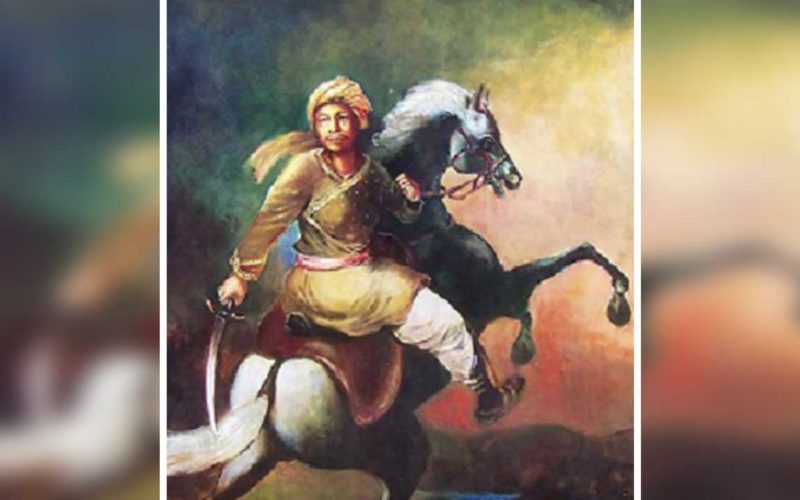- 16.0Kshares
- Share
- Tweet
- Facebook Messenger
I have always adored the underdogs who defied empires in history. But very little has been spoken about the legendary Assamese Ahom General Lachit Borphukan. Like Chhatrapati Shivaji, Lachit Borphukan was also a wily and fierce General who refused to let the Mughal rule the North-East.
And just like Marathas in Maharastra, the NorthEast has preserved its rich culture because heroes like Lachit Borphukan stood up against the tyranny of dictators.
Before we know more about his greatness a bit of a background –
The Authoritarian Mughal Rule under Aurangazeb –
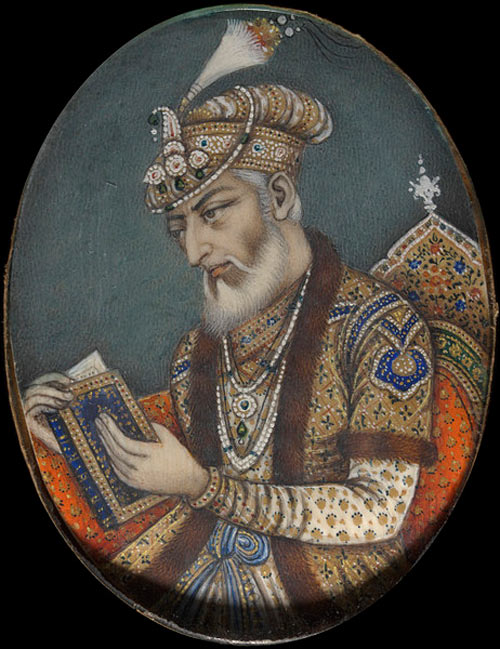
Aurangazeb was an expansionist Mughal emperor, who wanted his rule to be spread across a wide swath on the Indian subcontinent.
He was also a conservative ruler and was not liberal with the ideologies of other religions. Aurangzeb conquered and occupied the largest empire held by the Mughals. He coerced the weak and conquered the rebellious and established his totalitarian regime over them.
Some people resisted this rule –
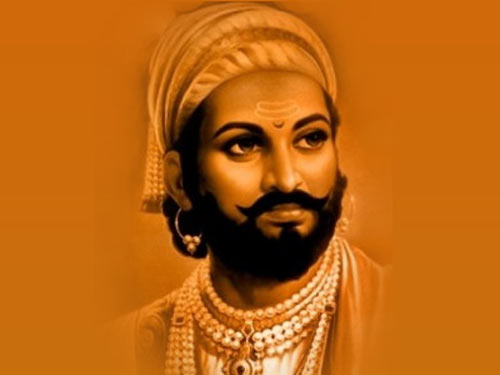
Such kings never have stable kingdoms and revolts broke out eventually. Guru Tegh Singh Bahadur to the north, Chattrapati Shivaji Maharaj in the west and Lachit Borphukan in the Northeast.
Lachit Borphukan
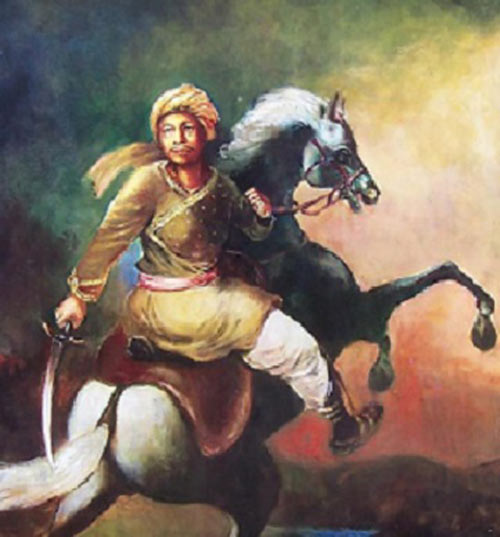
Lachit Borphukan was born to the first governor of Assam Momai Tamuli Borbarua. He was instructed in humanities, military tactics and holy scriptures and turned out to be an excellent man early on.
He was appointed as the principal secretary to the Ahom kingdom. Proving his mettle against the Mughal rule, he wrested Guwahati out of the Mughal hands, which further angered Aurangzeb and made the then Ahom king to make Lachit Borphukan the general of the forces against the Mughals.
The Battle of Saraighat –
1. Aurangazeb was furious when Lachit Borphukan recaptured Guwahati
To the point that he allotted a massive army of 4000 troopers, 30,000 infantry, 21 Rajput chiefs with their contingents, 18,000 cavalries, 2000 archers and 40 ships.
That’s a big army to conquer the Northeast.
2. He appointed Ram Singh of Amber to lead the Mughal forces and recapture Guwahati
Ram Singh was appointed for the sole task of recapturing Guwahati, and by extension – conquering and bringing the whole Northeast under the Mughal rule
3. Lachit Borphukan made the entry on land impossible
The Mughals were experts on land warfare. They conquered the entire Indian subcontinent on horsebacks. Lachit Borphukan knew he had no chance of thwarting a Mughal attack on land. So he built mud embankments to halt
4. The Mughal army was the weakest on waters and Lachit exploited this vulnerability
Although the Mughal army had 40 ships, it did not have much experience in water warfare and Lachit knew this. On the other hand the Ahom warriors were very skilled at river warfare, since it was their territory.
5. Lachit made a strategic hold at Guwahati on the Brahmaputra river
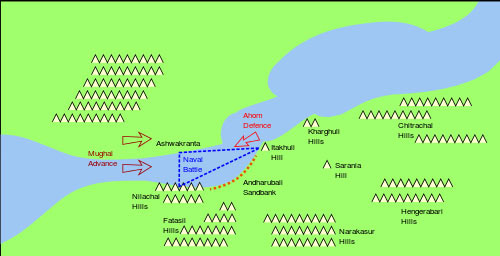
When the large Mughal contingent approached the Ahom army, Lachit strategically retreated, giving the Mughal an idea that his army was somehow afraid. His final stand would be Guwahati, on the Brahmaputra river.
6. He regularly harassed the Mughal Army With Guerilla Tactics
As the Mughals advanced, the Ahom warriors regularly harassed the Mughals with Guerilla warfare.
7. One such tactic failed and the Ahom lost 10,000 men.
One such skirmish failed and the Mughal cavalry butchered 10,000 Ahom warriors. Ram Singh made a proposal to the Ahom king Chakradwaj Singha to surrender to his terms. The proposal was rejected outright.
9. Lachit Borphukan fell ill and the Ahom almost lost all hope
While leading the skirmishes Lachit Borphukan fell ill and the Ahom warriors were all demoralized.
10. Lachit Borphukan put aside his illness and led from the front
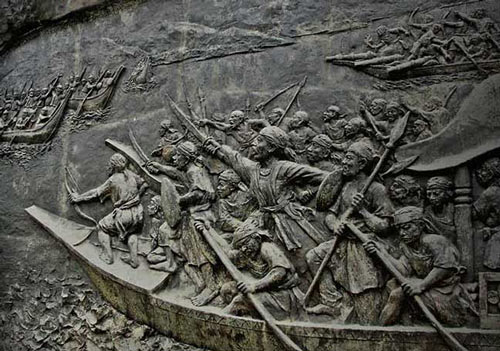
During the last stand, the Mughals loaded all the ships with cannons and warriors for the final assault. Lachit Borphukan made the inspiring speech –
“When my countrymen are suffering from invasion, and when my army is fighting and sacrificing its life, how can I think about resting my body due to a mere illness? How can I think about going home to my wife and children when my entire country is in trouble?”
He led from the front, despite his illness employing all the tactics he had learnt during his life.
11. The Mughal admiral Munnawar Khan was shot dead from the rear
The Ahom army assaulted the Mughals from the front and the rear, which caught them off-guard. The Mughal admiral was shot in the back during this assault.
With no commander to supervise the troops, the Mughal army fell into a disarray. Lachit Borphukan gave them a chase until they left the Ahom territory.
12. The Northeast remained under sovereign rule
The northeast remained under Ahom rule and the Mughals failed to capture it because of Lachit’s valiant efforts and leadership.
It is easy to rule a huge army, sitting in your comfortable darbars and barking orders. It is so much more difficult to lead a small army against a Goliath and come out winning. And to lead means digging the trenches with the regular soldier and actually taking part in the skirmishes and battles against the army.
Lachit Borphukan was a strategist extraordinaire and also had the courage of a lion – a deadly combination.
The best cadet to pass out of the National Defence Academy gets the Lachit Borphukan gold medal.
I always knew that this medal is prestigious in itself but never knew it was named after the legendary Ahom commander.
The NDA also has a bust of Lachit Borphukan installed at the entrance with the battle of Saraighat inscribed on the tablet below.
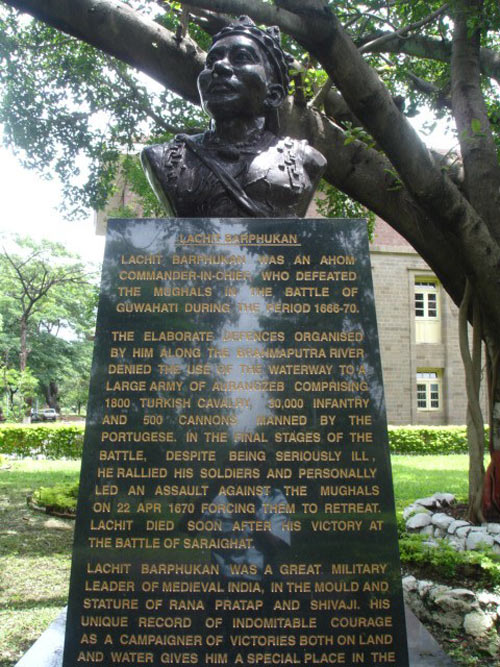
It is high time we remembered this great warrior and gave him the respect he truly deserves.
- 16.0Kshares
- Share
- Tweet
- Facebook Messenger




